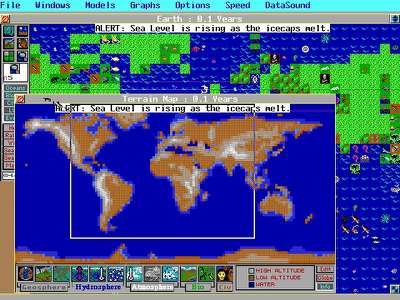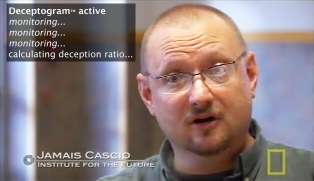 (The Big Picture is my series on the major driving forces likely to shape the next 20 years. The first post, on Climate Change, went up in early February.)
(The Big Picture is my series on the major driving forces likely to shape the next 20 years. The first post, on Climate Change, went up in early February.)
Truism #1: Human society's continued existence depends on the sustained flows of a variety of natural resources.
Truism #2: What that set of natural resources comprises can change over time.
We (the human we) have pushed the limits of many of the resources our civilization has come to depend upon. Oil is the most talked-about example, but from topsoil to fisheries, water to wheat, many of the resources underpinning life and society as we know it face significant threat. In many cases, this threat comes from simple over-consumption; in others, it comes from ecosystem damage (often, but not always, made worse by over-consumption).
The most obvious cause of over-consumption is population. Long a contentious issue for environmentalists, the argument that "we have too many people," logical in theory, faces serious ethical questions when turned to practice. One example: how do we decide who gets to continue living? Over-consumption is compounded by rising standards-of-living allowing more people to consume even more than before, and by a historically-rooted assumption that the Earth is big and can always provide.
But some resources simply have limits -- there's a maximum amount of oil to be extracted, or copper to be dug up. Some resources (topsoil, fisheries) can renew themselves, but at a rate far slower than our use. Unfortunately, what we've seen from other dwindling resources is that humans have a tendency to try to grab the last bits for themselves, even at the expense of others. This is the so-called "tragedy of the commons," and its most visible present-day manifestation has to be ocean fisheries. Many seafood species are the on the verge of total collapse, perhaps even extinction; official efforts to limit or halt fishing of certain species face desperate communities dependent upon the industry.
The other driver for resource collapse, ecosystem damage, is somewhat more complex. In some cases, such as honeybees, we still have little certainty as to why the resource is in such danger. In the case of wheat, the risk comes from a combination of human and natural activity.
If you hadn't heard that wheat is threatened, you're not alone. It's a relatively recent problem: a fungus known as Ug99. Emerging in Uganda in 1999 (hence the name), this black stem rust fungus seemed to be slowly moving north into the Middle East, not yet hitting locations dependent upon wheat as a primary food crop; this slow movement seemed to offer biologists time to come up with effective counters and to breed resistant strains of wheat, a time-consuming process. But that luck didn't hold.
...on 8 June 2007, Cyclone Gonu hit the Arabian peninsula, the worst storm there for 30 years.
"We know it changed the winds," says Wafa Khoury of the UN Food and Agriculture Organization in Rome, because desert locusts the FAO had been tracking in Yemen blew north towards Iran instead of north-west as expected [...]. "We think it may have done that to the rust spores." This means, she says, that Ug99 has reached Iran a year or two earlier than predicted. The fear is that the same winds could have blown the spores into Pakistan, which is also north of Yemen, and where surveillance of the fungus is limited.
In Iran, the spore will encounter barberry bushes, which trigger explosive reproduction of Ug99 (and more potential for mutation). From Iran to Pakistan, and then to India (much more dependent upon wheat) and to China. From China, it can blow to North America (as dust and soot do already). The fungus ignores current strains of wheat with fungal resistance, because it initially faced monocultures of wheat with single markers for resistance, allowing for easy mutation and replication.
I'm just glad the Norwegian seed vault is now up and operating. But as disturbing as the potential for collapse may be, the second truism listed above offers cause for hope.
Ecosystem services is the term to remember this time around. It's tempting to think of ourselves as dependent upon the resources we currently use, but that's not quite right. What we depend upon are the services the various resources provide -- the energy, for example, or the protein. In principle, if we can receive those service a different way, we may avoid the repercussions of the collapse of a particular resource. It's true that, in some cases (like water), the resources effectively are the services, but even here, we have to be careful not to think of a particular source (e.g., aquifers) as being the only possibility.
Bird poop provides an instructive example. In the 19th century, guano from birds native to Peru offered the world's best form of fertilizer -- so good that guano became the subject of imperial ambitions, national laws, and international tension. In "When guano imperialists ruled the earth," Salon's Andrew Leonard quotes from President Millard Fillmore's 1850 state of the union address:
Peruvian guano has become so desirable an article to the agricultural interest of the United States that it is the duty of the Government to employ all the means properly in its power for the purpose of causing that article to be imported into the country at a reasonable price.
But by the end of the century, the market for guano had collapsed, along with Peru's economy, because of the development of industrial "superphosphate" fertilizer. It's worth noting that, even if superphosphate hadn't been developed, Peru would have been in trouble -- the supplies of guano were just about depleted by the time the market collapsed. That's right: The world was facing "Peak Guano," only to be saved by catalytic innovation.
Resource Collapse and... Climate Change
I addressed this in The Big Picture: Climate Change, but as I noted a week or so ago, a recent article by NASA's James Hansen points to another point of intersection. In "Implications of “peak oil” for atmospheric CO2 and climate" (PDF), Hansen and colleague Pushker A. Kharecha argue that the effort to keep atmospheric carbon levels below 450ppm (widely considered the seriously bad news tipping point) may be greatly helped by limitations on the amount of available oil. With a reasonable phase-out of coal, active measures to reduce non-CO2 forcings (including methane and black soot), and draw-down of CO2 through reforestation, limiting CO2 to 450ppm can be readily accomplished due to limits on oil reserves. This doesn't require the most aggressive peak oil scenarios, either -- simply using the US Energy Information Administration's estimates of oil reserves is enough. Using more aggressive numbers, atmospheric CO2 peaks at 422ppm.
We may end up avoiding catastrophic climate disruption despite our own best efforts.
Resource Collapse and... Catalytic Innovation
The clearest connection between resource collapse and catalytic innovation is in the realm of substitution services. Nobody wants oil, for example, people want what can be done with oil. That can mean other forms of energy, such as electricity (for transportation), or it may mean other sources of hydrocarbons, such as thermal polymerization (for plastics), and so forth. The big concern: will the substitute technologies be ready by the time the resource is (effectively) gone?
Often, the issue really isn't technology, but expense and willingness to change. Driving the cost of alternatives down to make them competitive with the depleting resource can be difficult; even more difficult can be getting people to accept a substitution service that isn't exactly like the old one (even if it's objectively "better"). Cultured meat would be far and away better than today's meat processing industry -- environmentally, ethically, health-wise -- but, even if the product looked, tasted and felt just like "real" meat, a substantial number of people would likely avoid it simply because it was weird.
More important may be questions of culture and "ways of life." Substitutions rarely mean the same workforce providing one resource shifts seamlessly over to its replacement; more often, the substitute comes from an entirely different region, or may require different kinds or numbers of workers.
It also means a change in mindset or interpretations of the world around us. I've commented before about the imminent emergence of photovoltaic technologies allowing us to make nearly any surface a point of power generation. To an extent, this seems superficially obvious, but try taking a walk or drive with your mind's eye set on what would be different with a solar world. What rationale would we have, for example, for not giving any outside surface a photovoltaic layer? How would we design the material world differently? What would disappear -- and what would suddenly become ubiquitous?
Or there may be larger issues of infrastructure delaying an otherwise "easy" transition. Take alternative power vehicles: in many ways, making the cars & trucks run on clean energy will be the easy part. Think of all of the gas stations that would have to change or go out of business; think of all of the jobs lost when old skills become less valuable; think of the thousands of car repair places needing to retrain and retool. If you take the scenario I posited in The Problem of Cars last year, imagine all of the elements of the present day that would have to change in order for it to become possible.
Resource Collapse and... Ubiquitous Transparency
As with the climate, the role of ubiquitous transparency is to keep a close eye on the flows of production and consumption that might otherwise be invisible (at least until it's too late).
The scientific benefits would likely be the proximate driver. Whether the ultimate users are regulatory officials or participating panopticoneers depends on the balance of top-down vs. bottom-up power. Ultimately, it won't just be the points of production being watched, it will be the points of consumption, as well.
Resource Collapse and... New Models of Development
This is both harsh and simple.
If the newly-developing nations persist in trying to follow a Western path of development, then the competition for dwindling resources will end up as a critical point of tension and, likely, warfare. The more powerful nations will scrape by, while the ones less-able to throw their weight around will suffer. The more that the newly developing nations emulate Western consumption, the more that they're likely to face famine, economic collapse, and millions of casualties.
Conversely, if the newly-developing nations take a leapfrog-alternatives path, with a strong emphasis on efficiency and experimentation, they could find themselves the eventual winners of the century. The leapfrog concept is straightforward -- the areas with less legacy infrastructure can adopt new systems and models faster -- and emerging catalytic technologies and economic models seem custom-made for new adopters. But this isn't without risk; the new systems and models are intrinsically unproven, and may not work as well as expected. Leapfrogging nations may find themselves facing famine, economic collapse, and mass deaths anyway, and probably compounded by the expenditure of resources needed by the leapfrog systems and the loss or weakening of the old systems.
Resource Collapse and... The Rise of the Post-Hegemonic World
Resource collapse isn't the cause of the rise of the post-hegemonic world, but it's an important driver. It weakens the powerful, and opens up new niches of influence. It triggers conflict, setting the mighty against the mighty. It reveals vulnerabilities.
Most importantly, it sets up the conditions for the emergence of new models of power, as ultimately the most effective responses to resource collapse will come from revolutions in technology and socio-economic behavior. Those actors adopting the new successful models will find themselves disproportionately powerful.
Right now, none of the leading great power nations seem well-suited to discover and adopt such new models. The same can be said of the leading global corporate powers. The climate and resource crises of the 2010s and 2020s will be compounded by a vacuum of global leadership.
Ultimately, I suspect that the identity of the pre-eminent global actors of the mid-21st century will surprise us all.

 • Early Bright Green: "It is when man shall have discovered the means of restocking the sea and of controlling its supplies that his "dominion over the fish" will be perfect. The power to deplete, which so far marks the utmost limit of his advance, is mere tyrrany. Dominon should embrace a more benevolent sway, and to that end no doubt the efforts of science and the might of law will presently join forces."
• Early Bright Green: "It is when man shall have discovered the means of restocking the sea and of controlling its supplies that his "dominion over the fish" will be perfect. The power to deplete, which so far marks the utmost limit of his advance, is mere tyrrany. Dominon should embrace a more benevolent sway, and to that end no doubt the efforts of science and the might of law will presently join forces." The grand myth of environmentalism is that it's all about saving the Earth.
The grand myth of environmentalism is that it's all about saving the Earth. At one point during the multiple days of futures workshops held over the last week, one of my colleagues asked me where I'd learned to facilitate groups. After confirming that he thought I was doing it well, and wanted to learn more (as opposed to wanting to know what to avoid), I told him, and he was a little surprised. You might be, too.
At one point during the multiple days of futures workshops held over the last week, one of my colleagues asked me where I'd learned to facilitate groups. After confirming that he thought I was doing it well, and wanted to learn more (as opposed to wanting to know what to avoid), I told him, and he was a little surprised. You might be, too. Whenever I talk about the participatory panopticon, one issue grabs an audience more often than anything else -- privacy. But the more I dig into the subject, the more it becomes clear that the real target of the panopticon technologies isn't privacy, but deception. We're starting to see the onset of a variety of technologies allowing the user to determine with some degree of accuracy whether or not the subject is lying. The most promising of these technologies use
Whenever I talk about the participatory panopticon, one issue grabs an audience more often than anything else -- privacy. But the more I dig into the subject, the more it becomes clear that the real target of the panopticon technologies isn't privacy, but deception. We're starting to see the onset of a variety of technologies allowing the user to determine with some degree of accuracy whether or not the subject is lying. The most promising of these technologies use  Neologisms coming to mind during the Institute for the Future Ten-Year Forecast event (Updated):
Neologisms coming to mind during the Institute for the Future Ten-Year Forecast event (Updated):

